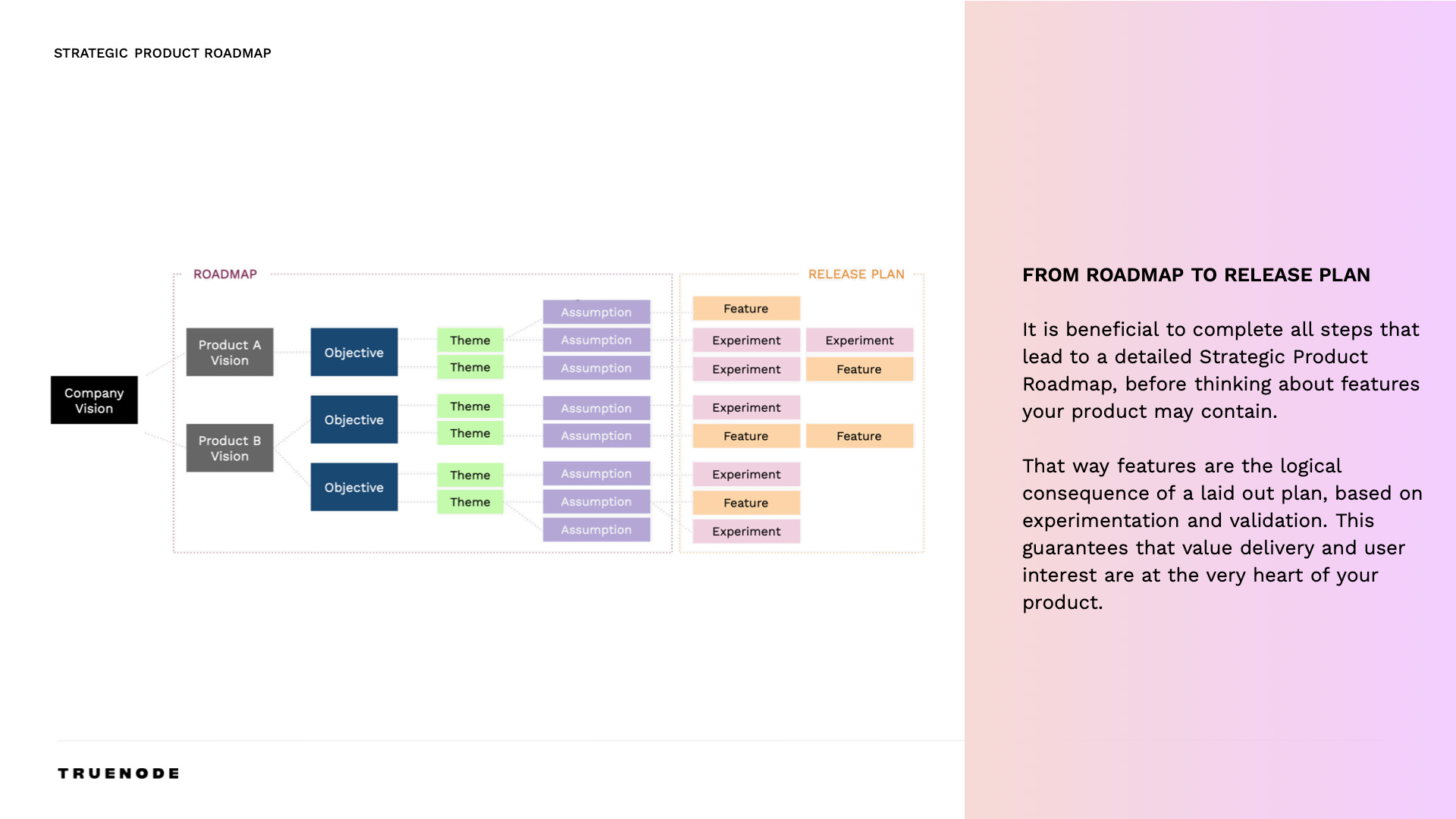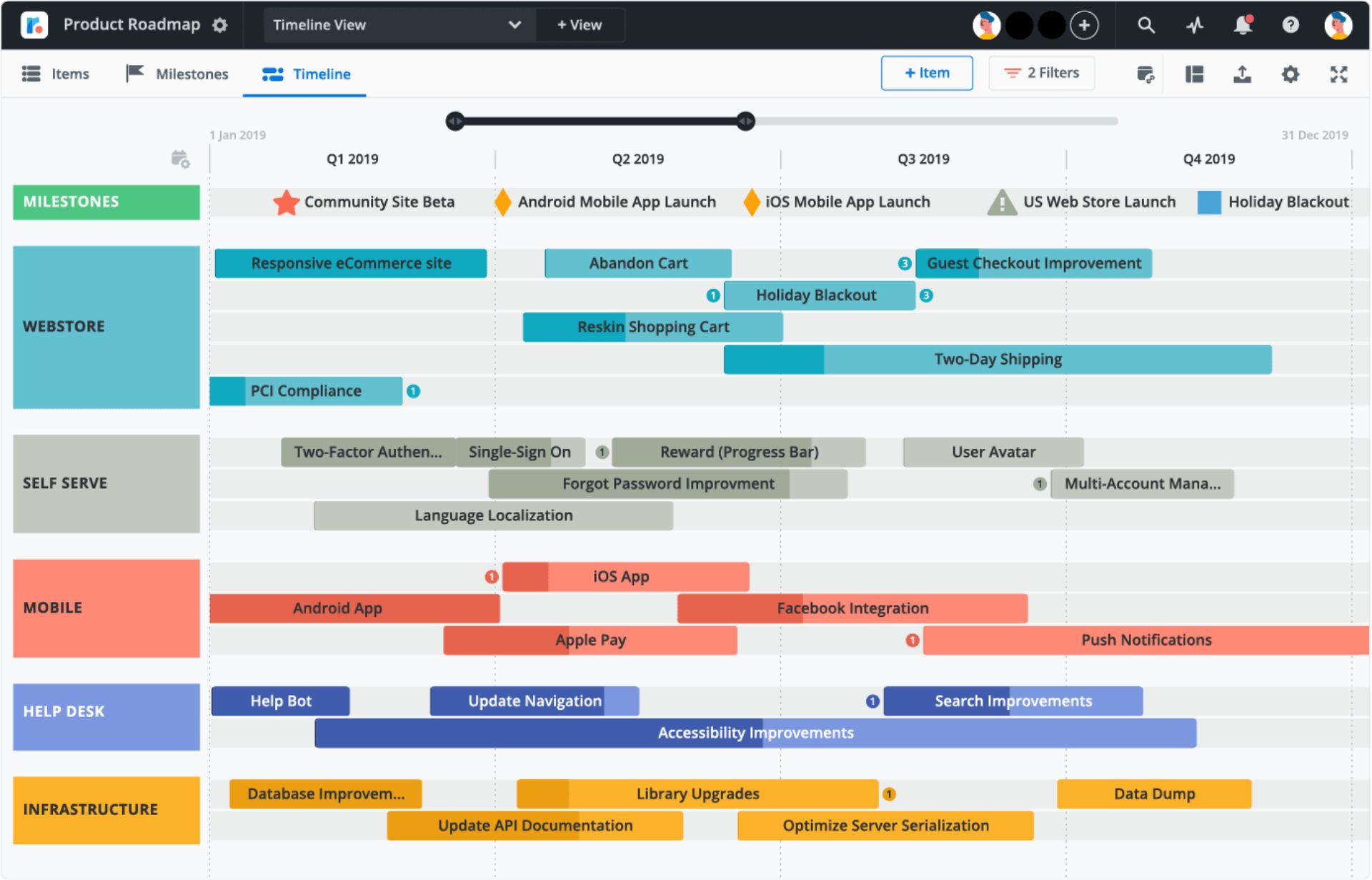Article

How To Develop Great Products by Utilizing The Strategic Product Roadmap
The secret to great product development
”When bringing a product to market, you need strong evidence that the product will solve important user pain points, while at the same time having the humility to continuously search for new evidence that may ultimately disprove the initial hypotheses.” – Facundo Gomez Vera, Head of Product at TrueNode.
What is a Product Roadmap?
Product roadmap is a visual guide, which shows how the company plans to develop their products over time to achieve their overall goals. It serves as a plan to help an organization achieve its vision in a sequential of steps and deliverables as well as an instrument of communication that shares strategic plans with everyone involved in the process.
At TrueNode, we use the strategic product roadmap as a principal guideline for our product development efforts. This guide will teach you how to develop great products by utilizing the strategic product roadmap.
How to strategically plan your Product Roadmap?
Developing great products can be a challenging process. Therefore, before you embark on the development journey, you should dedicate some time on crafting a strategic planning that will provide your team with strong tactical directions. Here are the tips to get started.
-
- Align the team and communicate the wider vision and approach for the product to all stakeholders without getting stuck in tactical details
- Focus on the value created by the product and the “why” behind it – by keeping a clear view of the problems it solves for the users, and the benefits it brings for the business
- Outline key assumptions that need to be validated
- Prioritize and plan with the bigger picture in mind, before moving on to the detailed development-oriented backlog
- Focus on outcomes and not on outputs
In addition, it is of great significance that you align your strategic product roadmap with your vision, key objectives, and North Star Metrics. However, leaving a room for flexibility during the execution is always helpful. Used in the right way, the strategic product roadmap will help you discover the right products and features to build before writing a single line of code.
The Importance of defining Product OKRs
Continual tracking and adjustments are part and parcel of all business processes. In that regard, measuring for the actual effects a released feature has on your customers should be among your top priorities. You can do this by asking questions like ”Is the feature we just released relieving the user’s pain?”, “Are users getting value out of the feature?”, or “Can we improve the feature based on our user’s desires?”.
Your product development team needs to figure out how they can break these outcomes down into measurable units and align them with the company goal(s).
That is where the strategic product roadmap can help. Planned in the right way, it creates alignment around the problems the product will solve for the user, along with the high-level goals for getting there. This will ultimately lead to products with more depth, stronger validation, and innovation in the individual teams.
A deep product may only solve a narrowly defined problem, but it does so in an excellent way. Instead of coming up with products that are addressing a wide variety of problems but fail to solve any one of them in a truly satisfying way, your teams will focus on delivering great value to your users where they most need it.
5 Steps to developing a Strategic Product Roadmap
In order to come up with a well crafted and thought out Strategic Product Roadmap, there are five steps that you can follow.
Step 1 – Start with a clear and compelling product vision
Make it clear why your product exists and where you want to be in five years. Even though we don’t know what will happen in five years it is important to achieve awareness, understanding, and commitment of your team.
Step 2 – Define objectives
Achieving these objectives should lead to realizing parts of your product vision and also to your company’s success. Make sure that your objectives are specific, measurable, achievable, realistic, and time-bound (also known as SMART objectives).
Step 3 – Focus on the user behaviors you need to change in order to achieve your objective
These are your themes (or outcomes). Make sure they are SMART too. Formulate your themes following a certain structure, including your starting and target metrics. Here’s an example of how this might look like:
- “Increase the total amount of weekly invoices sent per user from EUR 10.000 to EUR 20.000 by end of Q3”
- “By the end of next month, 87% of customer service requests will be resolved within 12 hours of receipt, regardless of the channel”
Step 4 – Identify opportunities for changing user behavior
These can be their problems, pains, gains, or jobs, which lead to the desired outcomes if you can solve them.
Step 5 – Hand over to your cross-functional product teams
Let them generate ideas based on your identified opportunities, validate which of these ideas actually solve the user’s problem (by using data and feedback), and create and iterate on the features until they produce the desired outcome and deliver measurable value.

Benefits of Creating a Strategic Product Roadmap
After completing the first steps until step four your teams will have:
- A clear and compelling product vision
- A set of objectives that they want to achieve
- Measurable outcomes they want to achieve, focused on the user
- A joint understanding of user problems, pains, gains, and jobs as opportunities that you need to solve in order to provide value to the user
- Enough flexibility to experiment during the process to drive innovation
In addition, up to this point, not a single line of code had to be written. Instead, a clear definition of success and tasks your teams need to focus on was established, giving it a point of reference it can always return to throughout the entire product development process.
Only after you have completed the four steps mentioned above, your teams should start working on step five and the actual features. Your team will need to constantly validate the respective features through design prototyping and rigorous feedback sessions with the actual user. This process ensures that your team always has the user perspective in mind.
According to a study by Jez Humble from 2012, over 60% of all feature teams use the HiPPO (Highest Paid Person’s Opinion) method for deciding what to build. With that approach, only 1 in 7 product features achieves any kind of measurable impact. By using the Strategic Product Roadmap you can effectively set yourself apart from most product teams and drive value for your customers.
The success of a product requires lots of trial and error and continuous validation with the actual customers. It is no surprise that companies like Amazon, Netflix, Google, and Facebook come up with great products. They are deeply focussed on the needs of their users and experiment constantly before moving to production.
The Strategic Roadmap is a truly agile instrument that will bring you one step closer to building products your customers love.
Product Roadmap tools, templates and examples
Good old fashioned Google sheets and Excel as well as Jira, Productboard, and visual collaboration tools like Miro can be used.
Note: Although the thought exercise is the most relevant aspect, making a clear roadmap that can be accessed on a periodic basis and is easy to understand is ideal.
The number of tools available on the market offer an infinite number of templates. Your job will be to pick the ones that work best for your product or business. Our suggestion is to start with a simple template and increase complexity as needed.
For additional resources you can check Itamar Gilad’s personal blog, an Ex-Google PM with many achievements under his belt.

Product Roadmapping mistakes you need to avoid
Product backlog shifts away from users
Too often product development teams get overly excited after defining the first steps and mistaken the development backlog for the roadmap. Thus, development goals become internally focused, and the focus shifts away from the users. Instead, everyone is looking towards the technical aspects of building the solutions. However, the technical feasibility of a feature is not a good indication of the significance that users will adopt the solution.
Forgetting to track outcomes
Highly detailed product roadmaps are rarely executed as planned. They cost energy and time to construct and shift the focus away from the user to individual features. This is one of the reasons why many “agile” product and engineering teams struggle to deliver value. Teams are either not validating their assumptions or are not measuring the desired impact they hope the product has on the user.
Failure to make roadmap adjustments
Often, product roadmaps are set up in a Gantt-like fashion, listing the desired features along a timeline. These roadmaps are very useful for go-live planning, as they provide a clear and well-structured overview. Especially at the beginning of your product journey, it is crucial to maintain flexibility and embrace the unknown. You simply can’t anticipate that your detailed roadmap will resonate with the user. In order to provide value to your customers and business, you should focus on outcomes rather than outputs.
Do you need help with your product roadmap?
If you are in the process of building your product roadmap and you are looking for help from an experienced team, at TrueNode, we have successfully completed over 100 projects and can assist you in your journey to market leadership.
The following are two examples of projects we have been working on.
Europe’s leading online pharmacy. A Germany based leading only pharmacy has been working with TrueNode since 2020. We provide full-cycle eCommerce web development and support their high-load customer-facing web platform. Learn about our on-going collaboration in this case study.
HDI’s first venturing into the growing freelancing market. Our team developed and implemented the product roadmap together with the HDI team. Our cross functional team of Software engineers, Product designers, and product managers, continuously validated, tested, and launched the features that made a successful impact on users. Learn more about how we onboarded over 3.000 users within a month of launch.
In our processes of building fast-growing software applications we rely on a validation-first approach and open communication principles, always making sure that our clients’ investment is well-optimized and well-paced. We put a great emphasis on discovering the real users’ needs and developing products that best meet their preferences.
To get to know TrueNode better, take a look at our projects.
To discuss your project, contact our team — we’ll reach out in no time!
Editor’s note: This article has been originally written by Louis Westendarp and published in July 2020 and has been completely revamped and updated for accuracy and relevance by Facundo Gomez Vera.






